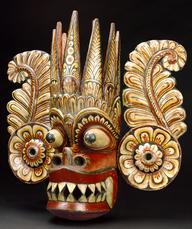





'lion'-shaped forceps, steel, Indian
Ancient instrument designs incorporated the heads of different animals. This replica example of a pincer instrument represents a lion’s mouth. The original was said to be used within Ayurvedic medicine. This ancient medical tradition has its roots in the Indian subcontinent. The name Ayurveda comes from ayus (‘life’) and veda (‘knowledge or science’). This indicates Ayurveda incorporates a whole way of living. Surgery (Shalya-chikitsa) is one of the eight ancient branches of Ayurvedic medicine. However, surgery has no clear identity today.
The Susrata Samhita is a classic text of Ayurvedic medicine. It describes a range of surgical practices. It was written by Hindu surgeon Susrata who practiced from about 500BCE.
Details
- Category:
- Asian Medicine
- Collection:
- Sir Henry Wellcome's Museum Collection
- Object Number:
- A643679
- Materials:
- steel
- Measurements:
-
overall: 10 mm x 240 mm x 60 mm, .35 kg
- type:
- surgical instrument and ayurveda




